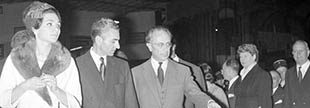The sight of antiquity here interrupts the continuity of the present time. Ruined structures, ancient or modern, it should be remembered, evoke other lives and worlds. Again, as Simmel saw it, the genuine ruin (ancient and decayed but not yet rendered unrecognizable in its fundamental formal features) creates “the present form of a past life,” and it does so in the fashion of “an immediately perceived presence.”4 But in the place where Simmel looked for “balance,” “unity of form,” “metaphysical calm,” and the reconnections of nature and the spirit in the face of opposition and conflict, cinema is capable of opening radical fissures even as it brings together. And so in Persepolis the ruin of the past, set against a forceful and lively present time, emerges as a ghostly interruption.
Margins of the funeral ceremony of Reza Davodenjad
[custom_adv]

